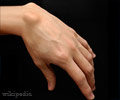Artificial sheath on natural bone cover could help faster healing in traumatic injuries like in a car wreck, bomb blast or disease that leaves too little cover.
Artificial sheath on natural bone cover could help faster healing in traumatic injuries like in a car wreck, bomb blast or disease that leaves too little cover.
Melissa Knothe Tate, a joint professor of biomedical engineering and mechanical & aerospace engineering at Case Western Reserve University, and Ulf Knothe, an orthopedic surgeon at the Cleveland Clinic, announce their work at the annual meeting of the Orthopedic Research Society in New Orleans this week.Knothe used the technique on a wheelchair-bound patient who suffered from cerebral palsy, hip dysplasia and a curved spine exacerbated by legs of differing length. To lengthen her shorter leg while correcting her hip dysplasia, he replaced the hip joint with a long-stemmed prosthesis, in the process cutting and spreading the femur to match the length of its mate. Around the newly-created gap in the femur he left a section of the periosteum, the bone's sleeve-like cover, intact to envelop and heal the gap.
Inside the sleeve, bone grew and matured around the prosthesis stem. The patient has since learned to walk again.
Why does the sleeve work?
"The sock-like sheath on the outside of the bone is a habitat for stem cells," Knothe Tate explained.
In testing on sheep in Switzerland, animals that had the periosteum operation to bridge a 1-inch gap in their leg stood within 24 hours and had substantial bone filling the gap within two weeks. In the lab, Knothe Tate and fellow researchers found that direct and angular pressure on stem cells from periosteum stimulated the cells to develop into bone. They believe the pressure of standing and shifting weight drove the bone growth in the sheep.
Advertisement
She tested the periosteum process against the standard bone graft technique of packing the gap with spongy bone taken from the pelvis and included a third model in which the gap was packed with spongy bone and covered with periosteum. The results showed the periosteum alone healed fastest and with the greatest density. "Surprisingly, including the bone graft slowed the healing process." she said.
Advertisement
Compared to the process called distraction osteogenesis, which uses pins inserted through the skin and into two lengths of bone to pull them together and bridge a large gap, the perisoteum procedure is far less invasive and less likely to result in infection and other complications.
Knothe, who has worked with patients suffering bone cancer or bone loss from traumatic injuries, knows that sometimes there is not enough periosteum to make a sleeve.
With support from the Case-Coulter Translational Research Program, the couple designed an artificial periosteum and Knothe Tate produced the novel implant, a sleeve made of materials approved by the Food & Drug Administration for other treatments. In sheep testing, collagen, collagen and cells scraped from periosteum, and pieces of periosteum were tucked into the artificial sleeves. Sheep treated with pieces of periosteum healed fastest, followed by those with collagen and cells.
"The next step is to bring the technology to the clinic, to broaden its access to the general public beyond the top clinics, for example for patients relying on hospitals in rural areas, as well as for soldiers injured on the battlefield," Knothe said. "You can sterilize the membrane in an autoclave, along with the surgical tools. Its modular design makes it easily adaptable to a variety of clinical situations."
The couple has filed for a patent on the artificial periosteum and is now working with other researchers to develop optimum materials to speed healing.
Source-Medindia
GPL











